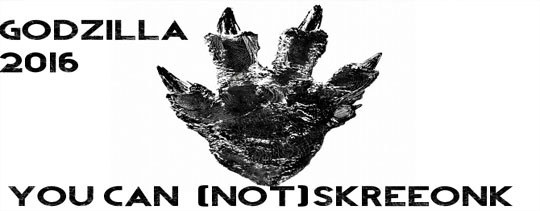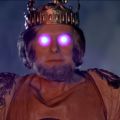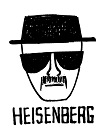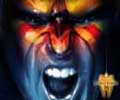Star Wars News Thread
Moderator: Controllers
-

metal_bryan - Controller
- Posts: 4249
- Joined: Fri Sep 23, 2005 3:59 am
- Location: Florida, USA
Re: WHUT?! Disney Buys Lucasfilm; STAR WARS VII in 2015!
As long as he makes sure to steer clear of Anaconda Malt Liquor.
-

jellydonut25 - Controller
- Posts: 18874
- Joined: Wed Dec 01, 2004 1:18 am
- Location: Houston, TX via Buffalo, NY
Re: WHUT?! Disney Buys Lucasfilm; STAR WARS VII in 2015!
Thought you guys might enjoy this. A little "Weird Al" parody that sums up Episode 1.
http://www.youtube.com/watch?v=hEcjgJSqSRU
http://www.youtube.com/watch?v=hEcjgJSqSRU
It's not the size of the dog in the fight that matters. It's the size of the fight in the dog!!
- ultramanmax
- Baby Godzilla
- Posts: 91
- Joined: Thu Nov 09, 2006 6:34 am
- Location: Massillon,Ohio
Re: WHUT?! Disney Buys Lucasfilm; STAR WARS VII in 2015!
http://www.superherohype.com/news/30132 ... pisode-vii
"The Ancient Fear"
Oh god...George Lucas is coming back! That's who Max Von Sydow is playing!
"The Ancient Fear"
Oh god...George Lucas is coming back! That's who Max Von Sydow is playing!
"We Can't Stop Here, This is Bat Country!"


-

MekaGojira3k - Millennium Godzilla
- Posts: 18288
- Joined: Sat Aug 09, 2003 11:13 am
- Location: Ky, USA
Re: WHUT?! Disney Buys Lucasfilm; STAR WARS VII in 2015!
ROBOT CO-OP IS GAMING COMEDY
https://robotco-op.com/
https://robotco-op.com/
-

Henry88 - Meltdown Godzilla
- Posts: 7114
- Joined: Sat Aug 09, 2003 3:06 pm
- Location: Heflin,AL
-

Dr Kain - Millennium Godzilla
- Posts: 11930
- Joined: Mon Jul 28, 2003 4:00 pm
- Location: Englewood CO but originally from Buffalo NY
-

jellydonut25 - Controller
- Posts: 18874
- Joined: Wed Dec 01, 2004 1:18 am
- Location: Houston, TX via Buffalo, NY
Re: WHUT?! Disney Buys Lucasfilm; STAR WARS VII in 2015!
^I don't know what any of that means.
-

jellydonut25 - Controller
- Posts: 18874
- Joined: Wed Dec 01, 2004 1:18 am
- Location: Houston, TX via Buffalo, NY
Re: WHUT?! Disney Buys Lucasfilm; STAR WARS VII in 2015!
There are "Despecialized editions" of the original trilogy made by a guy called Harmy. They are HD recreations of the original theatrical cuts of each film. The first versions (Despecialized Edition version 1.0) used HDTV broadcast captures of the original trilogy as the primary source and is still currently the only version of The Empire Strikes Back and Return of the Jedi. However, when the blurays came out, they were of higher quality than the tv broadcast captures so he started over using those as the primary video source. He had also gotten much better at many of the techniques he used and, through the resounding success of his first attempt, gained access to much better materials in the form of scans from 35mm prints, high res copies of original matte paintings, etc. provided by like-minded collectors who wanted to allow him to do the best work possible. He has since released version 2.0 of Star Wars (later re titled A New Hope) but there were some issues he discovered with that release and put out an updated version 2.1 soon after. He continued tinkering and has released an MKV file of version 2.5 which will eventually also be released as an actual bluray file with menus and everything. All previous releases have been in both the MKV and AVCHD file formats. AVCHD is a high definition format that can fit on a regular dual layer DVD and then be played back on most blu ray players. Since a lot of people (myself included) do not have blu ray burners, this was a great format and has been very popular.
The Despecialized Editions are incredible painstaking works of love where Harmy has gone through and literally changed back every single thing that was ever changed from the original theatrical versions. There are literally hundreds of things he changed back to be original that most people will never even know about on top of all the really obvious stuff. And his version 2.1 and 2.5 of Star Wars are the closest thing available to being able to see an original theatrical print. He was given acces to a privately held 1977 technicolor dye transfer print (the film is literally dyed instead of chemically processed, so unlike most film stock, the color never fades) to use as a color reference so his version is more accurate than any official home video release, ever. And much of the color timing is quite different than what we've been used to seeing on our TV's for the last 30 years.
The Despecialized Editions are incredible painstaking works of love where Harmy has gone through and literally changed back every single thing that was ever changed from the original theatrical versions. There are literally hundreds of things he changed back to be original that most people will never even know about on top of all the really obvious stuff. And his version 2.1 and 2.5 of Star Wars are the closest thing available to being able to see an original theatrical print. He was given acces to a privately held 1977 technicolor dye transfer print (the film is literally dyed instead of chemically processed, so unlike most film stock, the color never fades) to use as a color reference so his version is more accurate than any official home video release, ever. And much of the color timing is quite different than what we've been used to seeing on our TV's for the last 30 years.
-

canofhumdingers - Burning Godzilla
- Posts: 3046
- Joined: Fri Aug 08, 2003 11:17 pm
Re: WHUT?! Disney Buys Lucasfilm; STAR WARS VII in 2015!
ROBOT CO-OP IS GAMING COMEDY
https://robotco-op.com/
https://robotco-op.com/
-

Henry88 - Meltdown Godzilla
- Posts: 7114
- Joined: Sat Aug 09, 2003 3:06 pm
- Location: Heflin,AL
Re: WHUT?! Disney Buys Lucasfilm; STAR WARS VII in 2015!
That's awesome, because that thing would have been CG if Lucas had been in charge.
"We Can't Stop Here, This is Bat Country!"


-

MekaGojira3k - Millennium Godzilla
- Posts: 18288
- Joined: Sat Aug 09, 2003 11:13 am
- Location: Ky, USA
Re: WHUT?! Disney Buys Lucasfilm; STAR WARS VII in 2015!
http://www.tmz.com/2014/06/03/star-wars ... et-photos/
Looks like the X-Wings are getting a slight modification.
Looks like the X-Wings are getting a slight modification.
"We Can't Stop Here, This is Bat Country!"


-

MekaGojira3k - Millennium Godzilla
- Posts: 18288
- Joined: Sat Aug 09, 2003 11:13 am
- Location: Ky, USA
Re: WHUT?! Disney Buys Lucasfilm; STAR WARS VII in 2015!
It seems Harrison Fords injury is not so good for Star Wars either.
http://io9.com/harrison-fords-injury-ma ... 1594838394
http://io9.com/harrison-fords-injury-ma ... 1594838394
ROBOT CO-OP IS GAMING COMEDY
https://robotco-op.com/
https://robotco-op.com/
-

Henry88 - Meltdown Godzilla
- Posts: 7114
- Joined: Sat Aug 09, 2003 3:06 pm
- Location: Heflin,AL
Re: WHUT?! Disney Buys Lucasfilm; STAR WARS VII in 2015!
So, if they delay Episode 7....will they delay their other spinoffs and such?
-

jellydonut25 - Controller
- Posts: 18874
- Joined: Wed Dec 01, 2004 1:18 am
- Location: Houston, TX via Buffalo, NY
Re: WHUT?! Disney Buys Lucasfilm; STAR WARS VII in 2015!
Disney Will Release EPISODE VII In 2015 Or Kill Harrison Ford Trying
http://badassdigest.com/2014/06/27/disn ... ord-trying
http://badassdigest.com/2014/06/27/disn ... ord-trying
ROBOT CO-OP IS GAMING COMEDY
https://robotco-op.com/
https://robotco-op.com/
-

Henry88 - Meltdown Godzilla
- Posts: 7114
- Joined: Sat Aug 09, 2003 3:06 pm
- Location: Heflin,AL
Re: WHUT?! Disney Buys Lucasfilm; STAR WARS VII in 2015!
Hey, if it means them not having to spend the majority of their budget making Harrison Ford look like he is happy during post editing, I'm all for them writing his character out of the movie.

-

Dr Kain - Millennium Godzilla
- Posts: 11930
- Joined: Mon Jul 28, 2003 4:00 pm
- Location: Englewood CO but originally from Buffalo NY
Re: WHUT?! Disney Buys Lucasfilm; STAR WARS VII in 2015!
'Star Wars' cast gets two unknowns, takes break while Harrison Ford heals
http://edition.cnn.com/2014/07/07/showb ... index.html
http://edition.cnn.com/2014/07/07/showb ... index.html
ROBOT CO-OP IS GAMING COMEDY
https://robotco-op.com/
https://robotco-op.com/
-

Henry88 - Meltdown Godzilla
- Posts: 7114
- Joined: Sat Aug 09, 2003 3:06 pm
- Location: Heflin,AL
Re: WHUT?! Disney Buys Lucasfilm; STAR WARS VII in 2015!
Why don't they just shoot the scenes WITHOUT Harrison Ford in them?

-

Dr Kain - Millennium Godzilla
- Posts: 11930
- Joined: Mon Jul 28, 2003 4:00 pm
- Location: Englewood CO but originally from Buffalo NY
Re: WHUT?! Disney Buys Lucasfilm; STAR WARS VII in 2015!
Not real but real cool....
You must show no mercy, nor have any belief whatsoever in how others judge you... for your greatness will silence them all!
-

mrbluehair - Heisei Godzilla
- Posts: 1376
- Joined: Fri Aug 06, 2004 9:21 pm
- Location: California
-

Dr Kain - Millennium Godzilla
- Posts: 11930
- Joined: Mon Jul 28, 2003 4:00 pm
- Location: Englewood CO but originally from Buffalo NY
Re: WHUT?! Disney Buys Lucasfilm; STAR WARS VII in 2015!
'Star Wars: Episode VII' filming on Irish island causes flap with bird conservation group
http://www.nydailynews.com/entertainmen ... -1.1883912
Mark Hamill Reveals Secrets from the 'Star Wars: Episode VII' Set
http://abcnews.go.com/Entertainment/mar ... d=24711152
http://www.nydailynews.com/entertainmen ... -1.1883912
Mark Hamill Reveals Secrets from the 'Star Wars: Episode VII' Set
http://abcnews.go.com/Entertainment/mar ... d=24711152
ROBOT CO-OP IS GAMING COMEDY
https://robotco-op.com/
https://robotco-op.com/
-

Henry88 - Meltdown Godzilla
- Posts: 7114
- Joined: Sat Aug 09, 2003 3:06 pm
- Location: Heflin,AL
Re: WHUT?! Disney Buys Lucasfilm; STAR WARS VII in 2015!
‘Star Wars Episode VII’ Footage Is ‘Very, Very Exciting,’ Says Disney CEO
http://www.inquisitr.com/1395803/star-w ... isney-ceo/
http://www.inquisitr.com/1395803/star-w ... isney-ceo/
ROBOT CO-OP IS GAMING COMEDY
https://robotco-op.com/
https://robotco-op.com/
-

Henry88 - Meltdown Godzilla
- Posts: 7114
- Joined: Sat Aug 09, 2003 3:06 pm
- Location: Heflin,AL
Re: WHUT?! Disney Buys Lucasfilm; STAR WARS VII in 2015!
Of course the CEO of the company making the movie is going to say it's exciting...
-

canofhumdingers - Burning Godzilla
- Posts: 3046
- Joined: Fri Aug 08, 2003 11:17 pm
Return to Sci-Fi, Horror, and Fantasy Films and Television
Who is online
Users browsing this forum: No registered users and 8 guests
